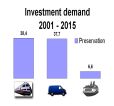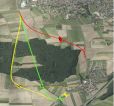| Economic feasibility studies |
Analysis • Planning • Measures • Determinations
| Cost-benefit analysis | |
 |
The evaluation of infrastructure measures concerning macroeconomic benefit is an important instrument for efficient
traffic planning under consideration of an
optimal use of public funds. As formalised evaluation methodology for infrastructure measures two works are to be named:
'Recommendations regarding cost investiga-tions on roads' (EWS 1997) and the 'Macroeconomic
Evaluation Methodology for the
Federal Trans- port Infrastructure Plan 2003', which was updated with significant in-volvement of MUVEDA staff members. These
procedures are frequently adjusted to specific questions, and they are used e.g. to evaluate traffic control and traffic
man-agement systems. The adjustment requires special knowledge regarding the background and the complex inter- relationship
of the methodology.
|
| Requirement and investment planning | |

|
Within the traffic policy planning of the Federal Government and Federal States an optimal use of public funds requires a
methodical evaluation of road construction projects. You have to assess the viability of a planned project and classify the
benefit in comparison to other construction projects. This is assured by a specific macroeconomic evaluation metho- dology for
requirement and investment plans. Among other activities we develop such methodologies in consideration of road type and regional
specifics as well as regulatory political objectives. With the developed methodologies we evaluate infrastructure projects and
support you during the classification of projects with regard to urgency of realisation and investment planning.
|
| Evaluation of measures | |
 |
The evaluation of a road construction investment according to the methodology of cost-benefit analysis provides significant
information about expected benefit and costs due to the realisation of planned projects. Primarily we assess the
viability of an infrastructure
measure from an macroeconomic point of view. Beside monetary results also physical impacts are considered for the
evaluation of planned measures.
|
| Comparison of alternatives | |
 |
Planning
of an infrastructure measure usually includes the consideration of several alternatives. On the basis of detailed
results of cost-benefit analyses the competing alternatives are scrutinised by comparison. With the results and information
of model calculations we can identify weak points of the alternatives in the present network structure and point out
alterations induced by measures. The comparative
analysis
of results allows the selection of the 'better' alternative from a macroeconomic point of view.
|



